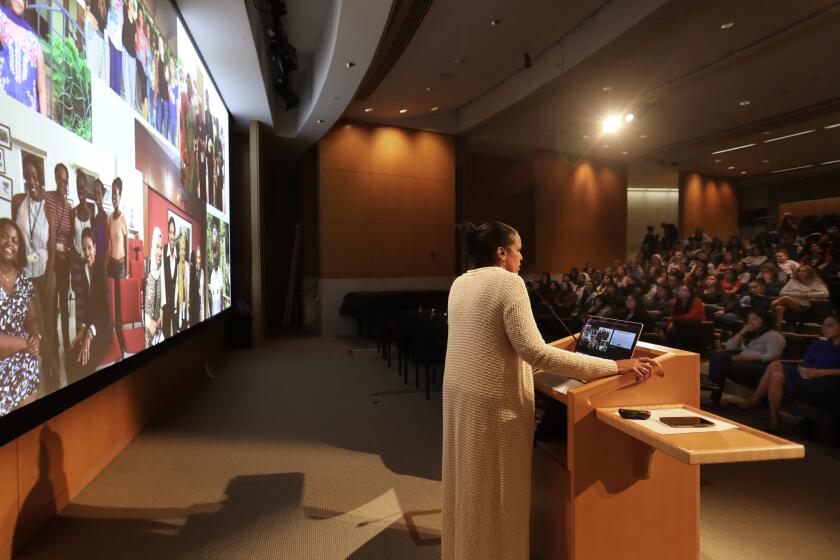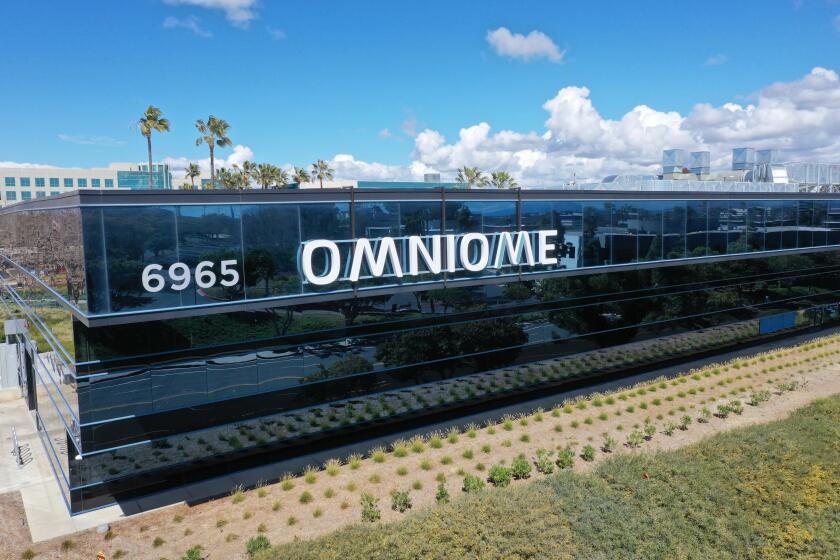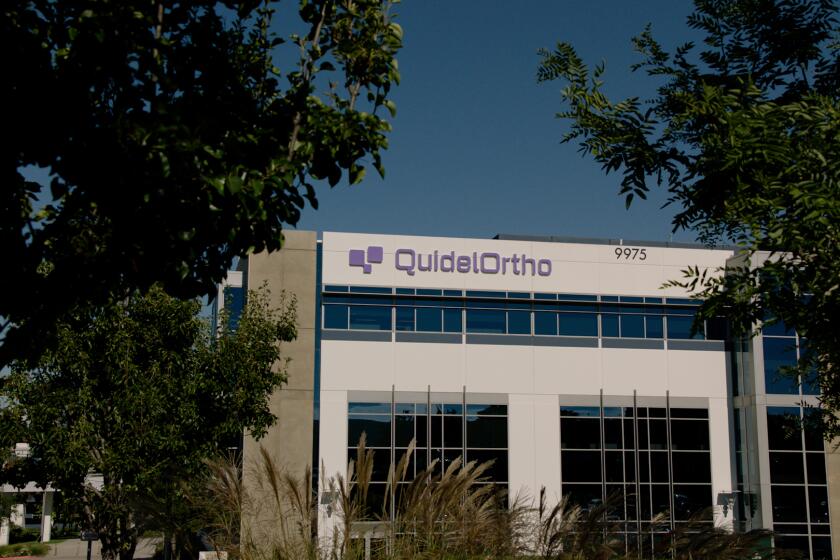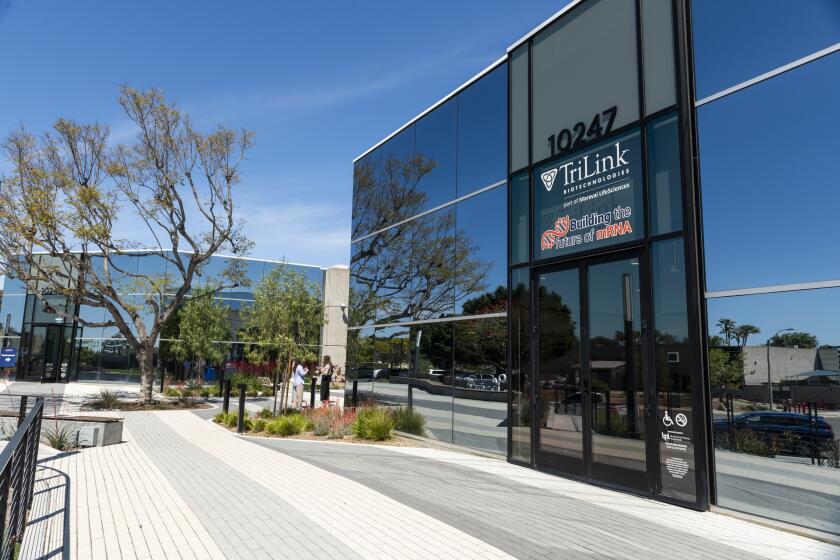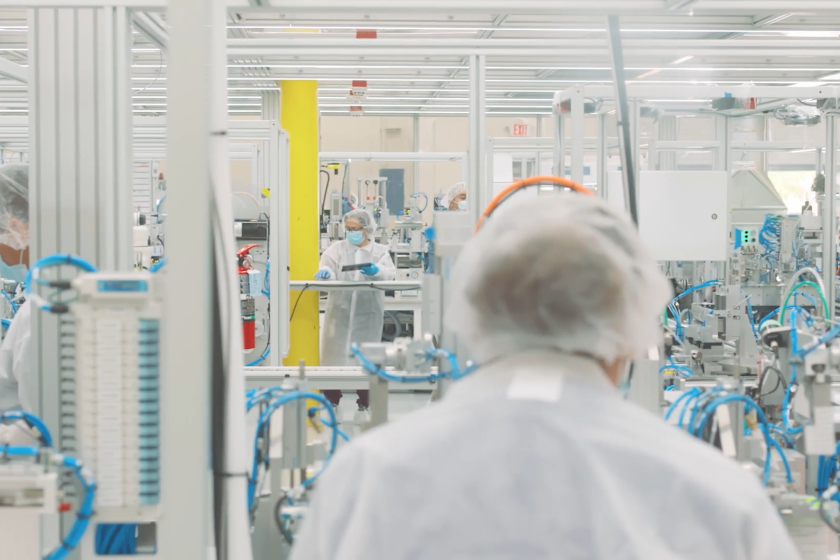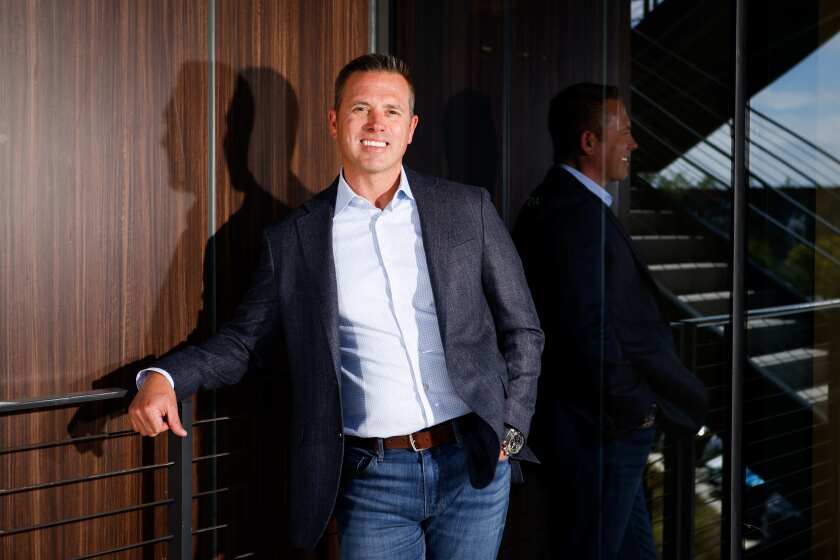Genome leader Illumina expands again in San Diego

Illumina innovative culture revealed in i3 campus
Like a child constantly outgrowing clothes, biotech giant Illumina has trouble keeping up with its continued expansion.
So on Monday, the San Diego genome sequencing leader is scheduled to open a new addition — a 7-acre, 316,000-square-foot complex called the i3 campus. Illumina considers it an extension of its headquarters, less than a mile away in University City.
i3 stands for “iconic,” “innovative” and “inspired” — three themes project developer BioMed Realty sought to embed in the project before Illumina signed a long-term lease for the property
Consisting of three buildings refitted for Illumina’s needs, the i3 campus emphasizes openness, with ample windows to the outside and an open-style office space inside. Amenities include a gym and a restaurant called “Salt + Air.”
And there are meeting rooms — lots of meeting rooms. Larger rooms, for formal presentations, can be reserved. Smaller ones, where one or two people can sit, are available for the innumerable spontaneous discussions that seem to be baked into Illumina’s DNA.
“Employees manage their own day and calendars, so we infused the i3 workplace with open and non-bookable places for employees to work — these can be visitors from the main HQ campus or employees from another site,” said Jenny Durbin, the company’s global facilities manager. “An employee can choose to work at i3 even if their team or department is based at the main campus.”
Illumina employs almost 7,000 people, nearly 3,000 of them in San Diego. Its stock is valued at more than $28 billion, making it by far the highest valued biotech in San Diego.
In January 2014, Illumina made international headlines by bringing down the cost of sequencing a human genome to below $1,000, with its HiSeq X Ten Sequencing System. And this January, the company announced machines in its NovaSeq line that can reduce the time to process a human genome to an average rate of one per hour, when many are processed in large batches.
As a result of such advances, Illumina dominates the market for DNA sequencers. It also leverages genomic technology into such fields as prenatal testing.
Because it’s impossible to know what scientific research will lead to new opportunities, Illumina makes sure its employees have flexibility, Durbin said. As biomedical research unveils new breakthroughs, Illumina races to translate the research into new products to serve the field, in government, academic and medical applications.
Design innovation
The i3 campus was designed by the Seattle architectural firm of Perkins + Will, and built by McCarthy contractors. Tucked onto seven acres at the east end of Executive Drive, its cantilevered buildings perched like hawks over Interstate 805.
“There’s a common theme working up and down the coast,” said design principal Ryan Bussard, “looking for innovation in architecture, tying together site design as well as architecture and collaboration spaces. The indoor and outdoor down here — you can really take advantage of that year-round.… It’s pretty unique.”
BioMed Realty held a design competition in 2011 that Perkins + Will won, five years before Illumina signed a lease for the property, and the architects and developers had to conceive a building before the users’ needs were known.
One of the first decisions was to demolish a never-occupied building and locate parking underground to gain more above-ground usable space.
“The siting of the building was kind of a invert of the traditional,” Bussard said.
That cost more but yielded “highly valued space,” including a 33,500-square-foot courtyard.
The second decision was to build three concrete-and-glass buildings and cantilever them out toward I-805 as much as 30 feet beyond the lower floors. The effect is to “float” above the landscaped fire lane where the company will host its first big event next month.
“It’s almost weightless,” he said.
The local inspirations? The Salk Institute and the J. Craig Venter Institute on Torrey Pines Mesa. About 40,000 cubic yards of smooth white concrete make up the structure, rather than a more traditional steel-and-glass framework.
That eliminated the need to locate elevators, bathrooms and other core facilities in the middle of the buildings and increased the flexibility of each floor’s layout.
The third decision was to set aside half the building to be used for lab space on the interiors and administrative space around the exterior walls. But Illumina chose to make the entire building into office space — a shift that could be reversed in the future.
“We build flexible space for the infrastructure to support,” Bussard said.
Inside the three buildings, the finance, marketing and other company executives will work to turn researchers’ inventions and findings into products and services.
Perkins + Will designers took the company’s philosophy of “work anywhere” and created interior design layouts that decouple staff from their desktop phones, computers and potted plants.
Large and small meetings will be scheduled in a variety of ground-floor spaces in Building B, located to the right of the campus entrance. One conference room can be extended to about 120 feet in length and voice-sensitive cameras can transmit the proceedings off campus.
A smaller “plaza lounge” at the end of the building offers a more informal space in a mid-century modern, ‘60s residential look. Durbin, the global facilities manager, called the approach “resimercial” — a mashup of residential and commercial design.
“It’s a blend between formal spaces and a more home-like space,” she said.
To orient employees no matter where they work, the same colors are being used floor by floor — the first floor is “pumpkin orange,” the second is blue and the third green. Abstract carpet patterns complement the color scheme.
“It’s important to have innovation and consistency,” said Norm Fjeldheim, senior vice president, chief information officer and head of global facilities.
Some employees will have assigned desks that can be adjusted for standing or sitting, while others can move day to day, depending the task at hand. At night they can store their personal items in lockers. For private phone conversations, there are 60 phone booths in the complex — but bring your own cell phone that links into the building’s WiFi network.
Global and local
Those desks and phone booths will be used by people not only from San Diego, but from around the world.
Besides San Diego, Illumina has offices in Hayward, Santa Clara, San Francisco, Redwood City, Madison, Wis.; and internationally in Victoria, Australia; Shangai and Beijing; Tokyo; São Paulo; Eindhoven, the Netherlands; Chesterford and Fulbourn, United Kingdom; Singapore; and Victoria, Canada.
As a company with a worldwide presence, Illumina uses technology to bridge the gap between its widespread locations, said Durbin said.
“I feel as an employee working across the globe that my team members and colleagues at the other sites feel just as close to me as my team mates here, because we make the efforts to use the technology (Jabber, message, box, video and teleconferencing) to bridge the distance,” Durbin said.
In San Diego, Illumina’s presence goes far beyond its direct employment. Local biomedical institutions such as Scripps Health, the J. Craig Venter Institute and Rady Children’s Hospital San Diego are Illumina customers. Illumina is also a longtime charitable supporter of Rady Children’s.
When babies show up at the hospital with unidentifiable serious illnesses, their genomes may be sequenced with Illumina products to find clues to their condition. This can save lives and prevent unneeded procedures.
Shimul Chowdhury, Rady Children’s clinical laboratory director, used to work for Illumina. As a board-certified molecular geneticist, he analyzes the genetic data from clinical reports and delivers them to physicians.
“My role as a laboratory director is really to be the bridge between the laboratory who presents the reports to our physicians in a manner that they understand and that is useful for them to be able to take care of their patients,” Chowdhury said.
At Illumina, he worked in the clinical laboratory, seeking to learn what information could be gleaned from a genome to make genome sequencing become routine in clinical practice. That required him to analyze patient samples and collaborate with doctors. He collaborated with Dr. Stephen Kingsmore, who heads the Rady Institute for Genomic Medicine.
As Chowdhury learned more about Rady Children’s, he decided to join the hospital to help put genomic technology into clinical practice. And his work still very much involves technology from Illumina.
“They’re providing the instruments and the reagents (supplies) to help us sequence kids,” Chowdhury said. “But it goes broader than that in terms of collaboration. We’re taking these sequencing technologies and testing them in patients in intensive care units. So I think our feedback is valuable to them.”
On a larger scale, he said Illumina’s presence in San Diego draws visibility to the use of the technology. “It really increases the genomics literacy of this region, which really helps us when we’re speaking to families, speaking to doctors,” he said.
Rady’s uses Illumina’s most advanced genomics instrument, the NovaSeq, Chowdhury said. With speed and accuracy, the instrument is important for searching for genetic causes of disease in children who may be critically ill and not have much time left.
“We really view this machine as a next step in our evolution for being able to provide rapid genomes for more and more kids in San Diego and throughout the United States,” he said.
For further reading
Illumina expands with massive new manufacturing building
Growth slowdown sinks Illumina
Illumina’s Jay Flatley named to Entrepreneur Hall of Fame
Cameron’s visit to Illumina continues San Diego’s British biotech invasion
Illumina CEO brings entrepreneurial spirit to genomics giant
Illumina makes big push in cancer screening
Illumina’s Flatley speaks of genomic future
Illumina helps doctors diagnose sick babies faster
Science Playlist

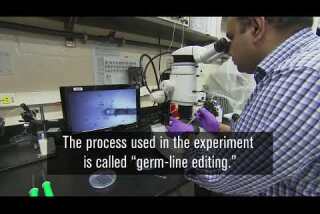
In a first, scientists rid human embryos of a potentially fatal gene mutation by editing their DNA

10 interesting facts about Mars

Kids can add years to your life

LA 90: SpaceX launches recycled rocket

Ocean temperatures warming at rapid rate, study finds
bradley.fikes@sduniontribune.com
(619) 293-1020
Get U-T Business in your inbox on Mondays
Get ready for your week with the week’s top business stories from San Diego and California, in your inbox Monday mornings.
You may occasionally receive promotional content from the San Diego Union-Tribune.



